Analyzing Spatial Distribution and Influencing Factors of Soil Organic Matter in Cultivated Land of Northeast China: Implications for Black Soil Protection
Abstract
:1. Introduction
2. Materials and Methods
2.1. Overview of the Study Area
2.2. Image Data
2.3. Data on Natural and Human Factors
2.4. Basic Data Analysis of SOM Content in the Northeast and Its Six Regions
2.5. Spatial Analysis of SOM Content in the Northeast and Its Six Regions
2.6. Driver Analysis Using Geodetector
2.7. Research Framework
3. Results
3.1. Basic Data Analysis of SOM Content in Various Regions
3.2. Analysis of Spatial Distribution Characteristics of SOM Content
3.2.1. Characteristics of SOM Spatial Distribution of Cultivated Land
3.2.2. Characteristics of SOM Content Distribution over Elevation
3.2.3. Characteristics of the Distribution of SOM Content over Annual Average Precipitation
3.2.4. Characteristics of the Distribution of SOM Content over Annual Average Temperature
3.2.5. Characteristics of the Distribution of SOM Content over the Slope
3.3. Analysis of Influencing Factors on Spatial Distribution of SOM Content
4. Discussion
4.1. Advantages of Remote Sensing-Based SOM Spatial Distribution Studies
4.2. Spatial Distribution Pattern of SOM in the Northeastern Black Soil Area
4.3. The Need for a Regional Approach in Different Black Soil Conservation Areas
4.4. Shortcomings and Prospects
5. Conclusions
- (1)
- The overall northeast region and various conservation zones exhibit distinct patterns of SOM change along environmental gradients such as DEM, slope, temperature, and precipitation.
- (2)
- The spatial distribution of SOM varies across the northeast region and its conservation zones, with more pronounced changes in certain subzones.
- (3)
- The annual average temperature is the primary factor influencing SOM distribution in the entire northeast region.
- (4)
- In different conservation zones, DEM and slope are the dominant factors affecting SOM distribution, likely linked to the progression of cultivated land reclamation.
- (5)
- Tailored measures should be implemented in different areas to address the declining trend of SOM in cultivated lands, providing critical guidance for the execution of cultivated land protection projects in black soil regions.
Author Contributions
Funding
Data Availability Statement
Acknowledgments
Conflicts of Interest
Appendix A
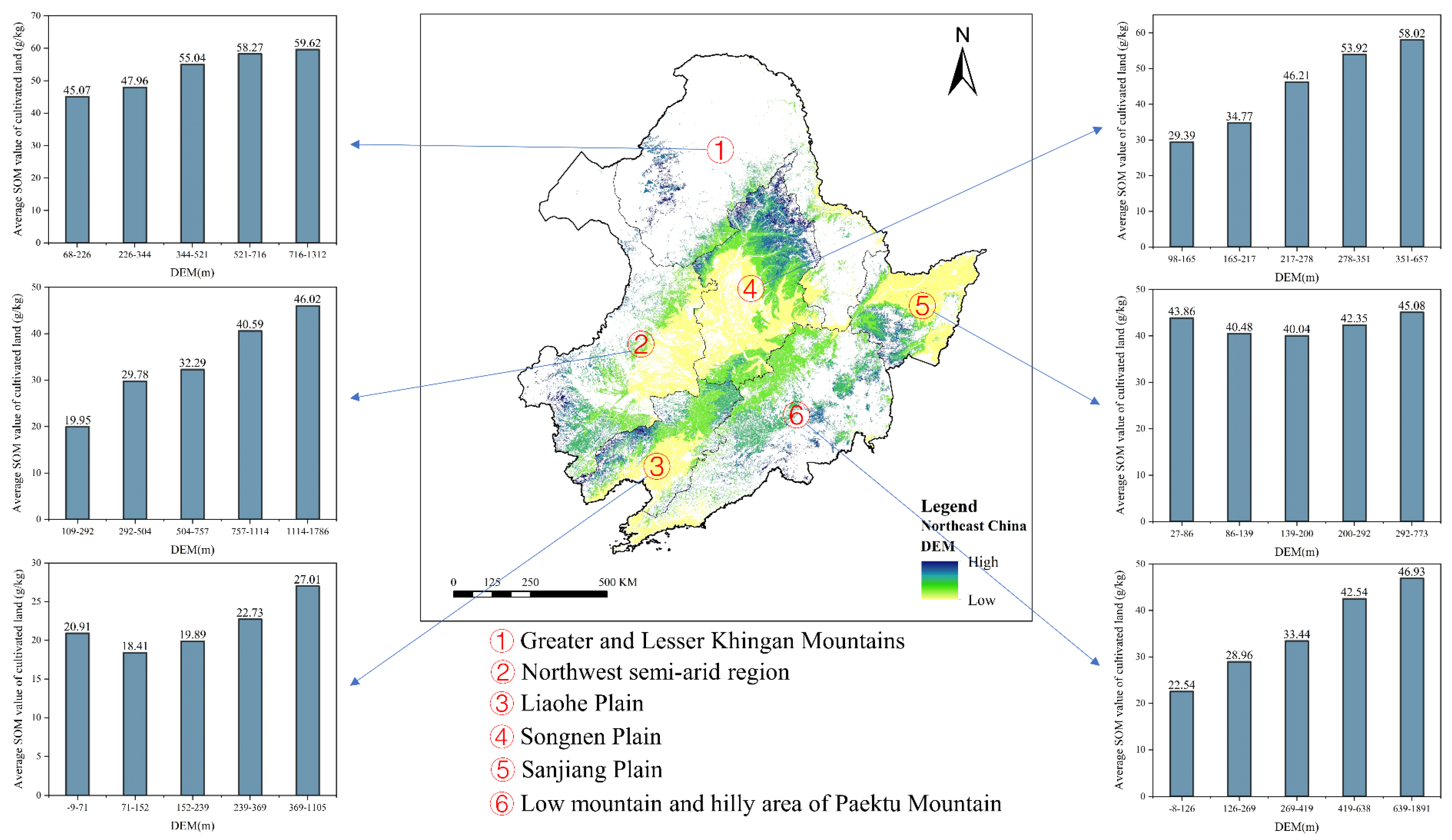
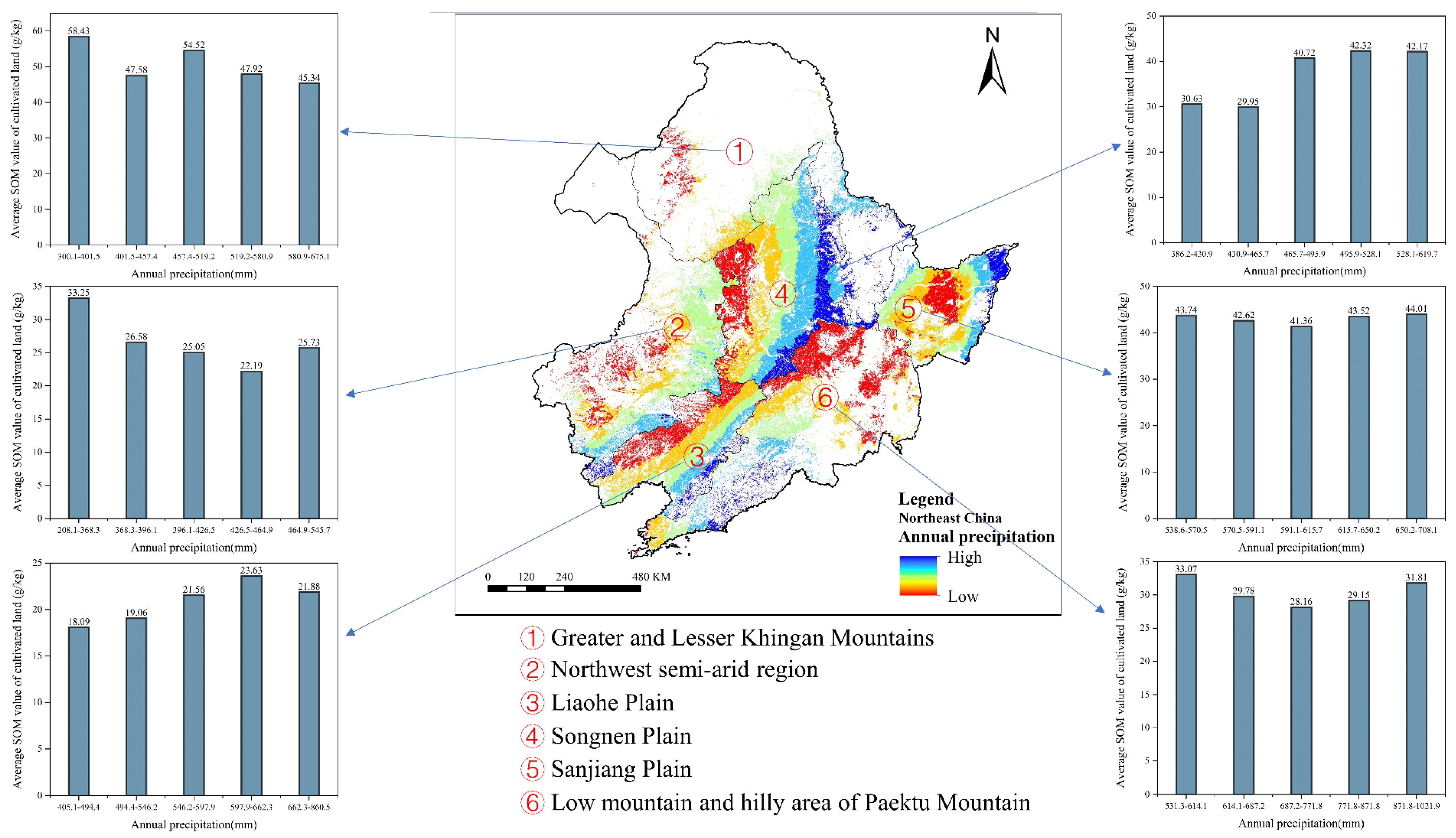
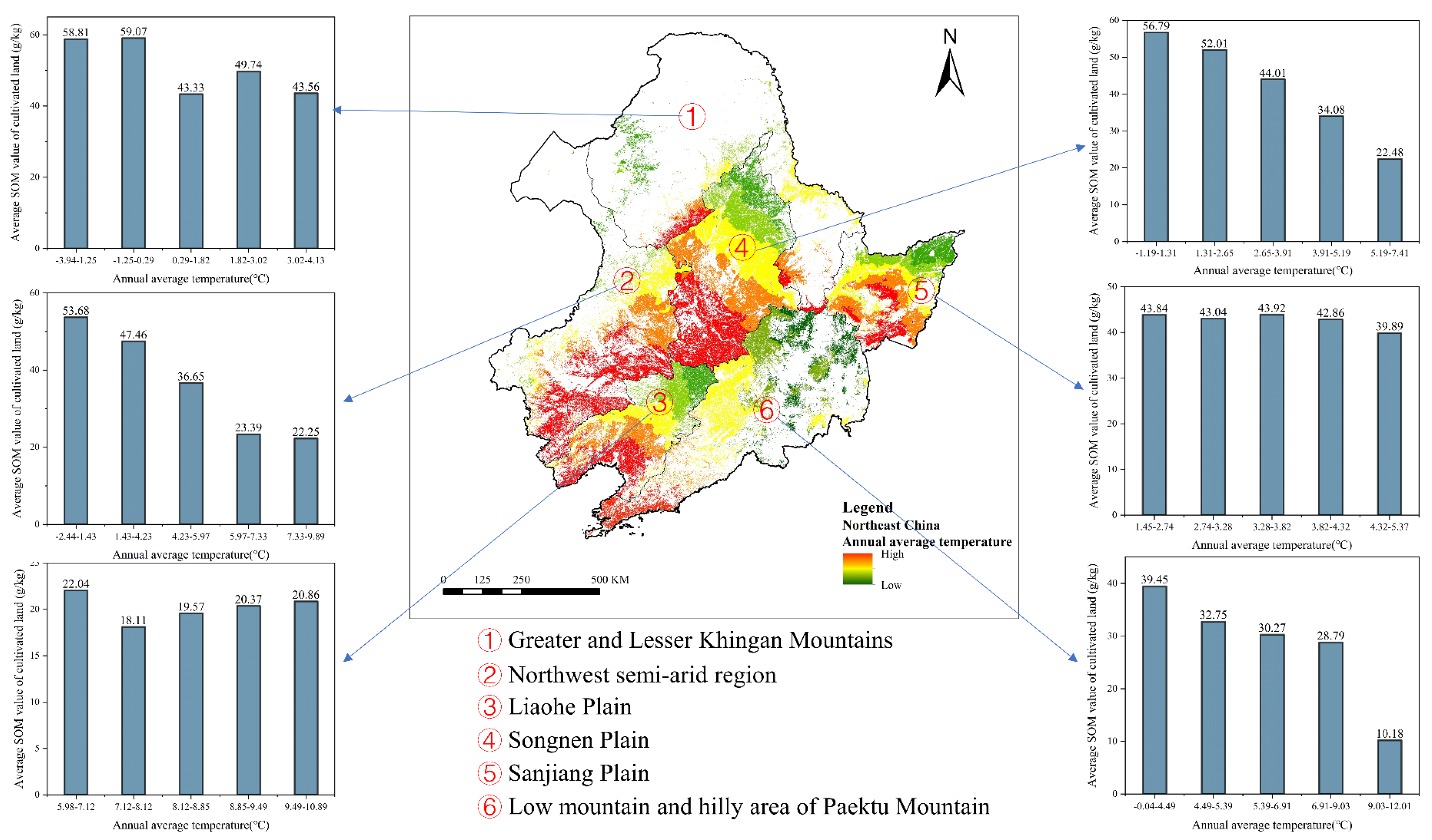
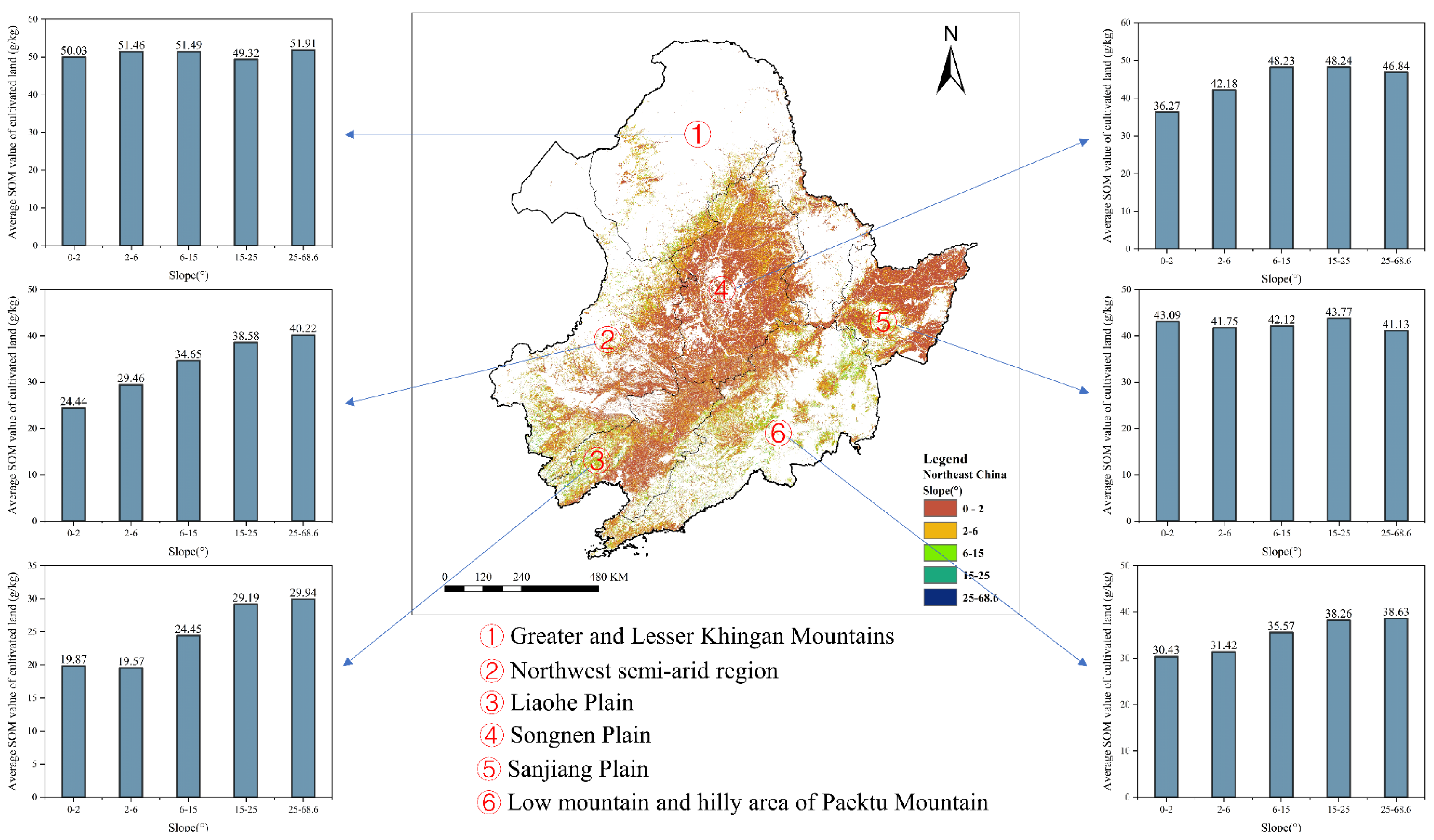

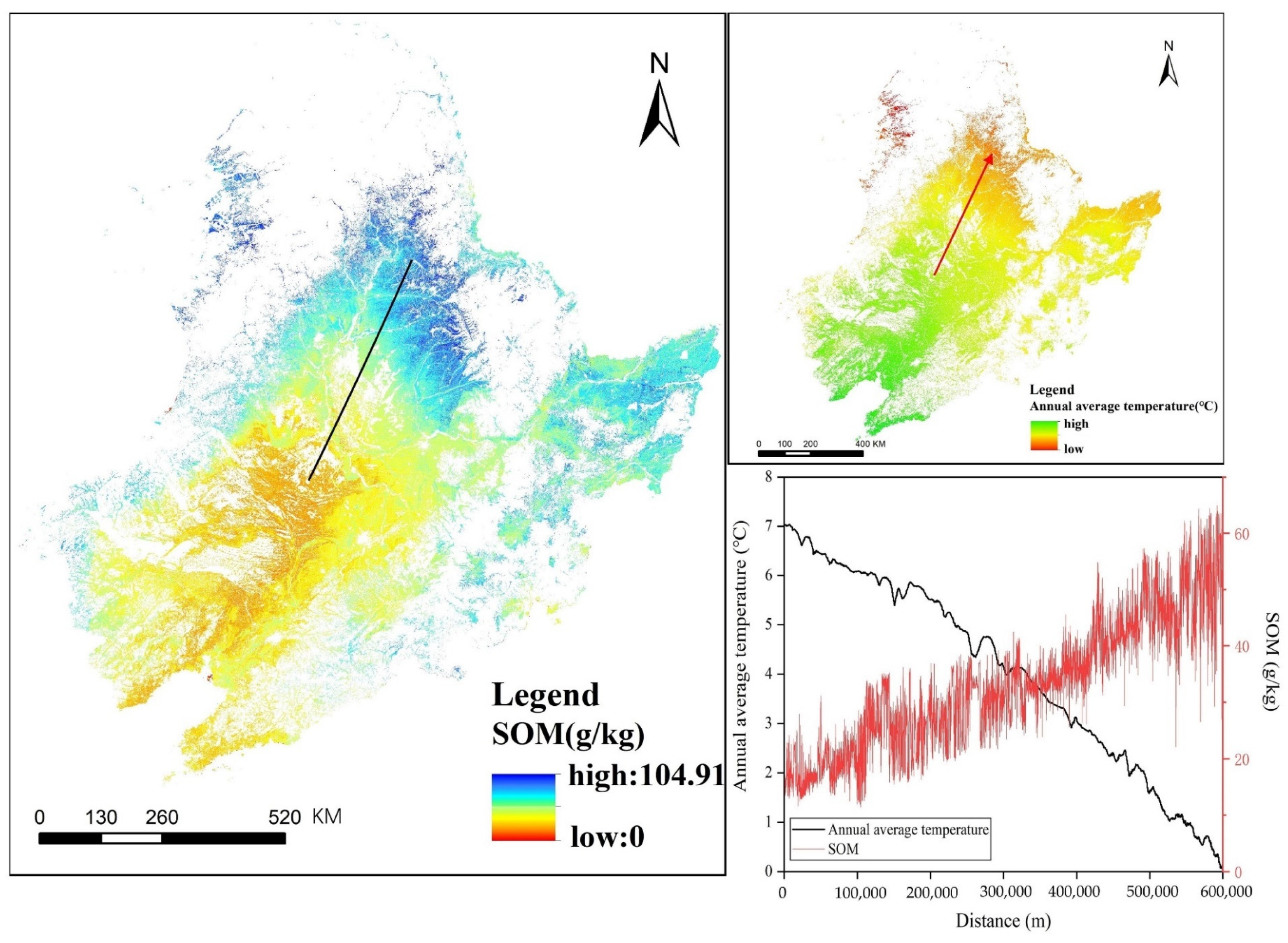
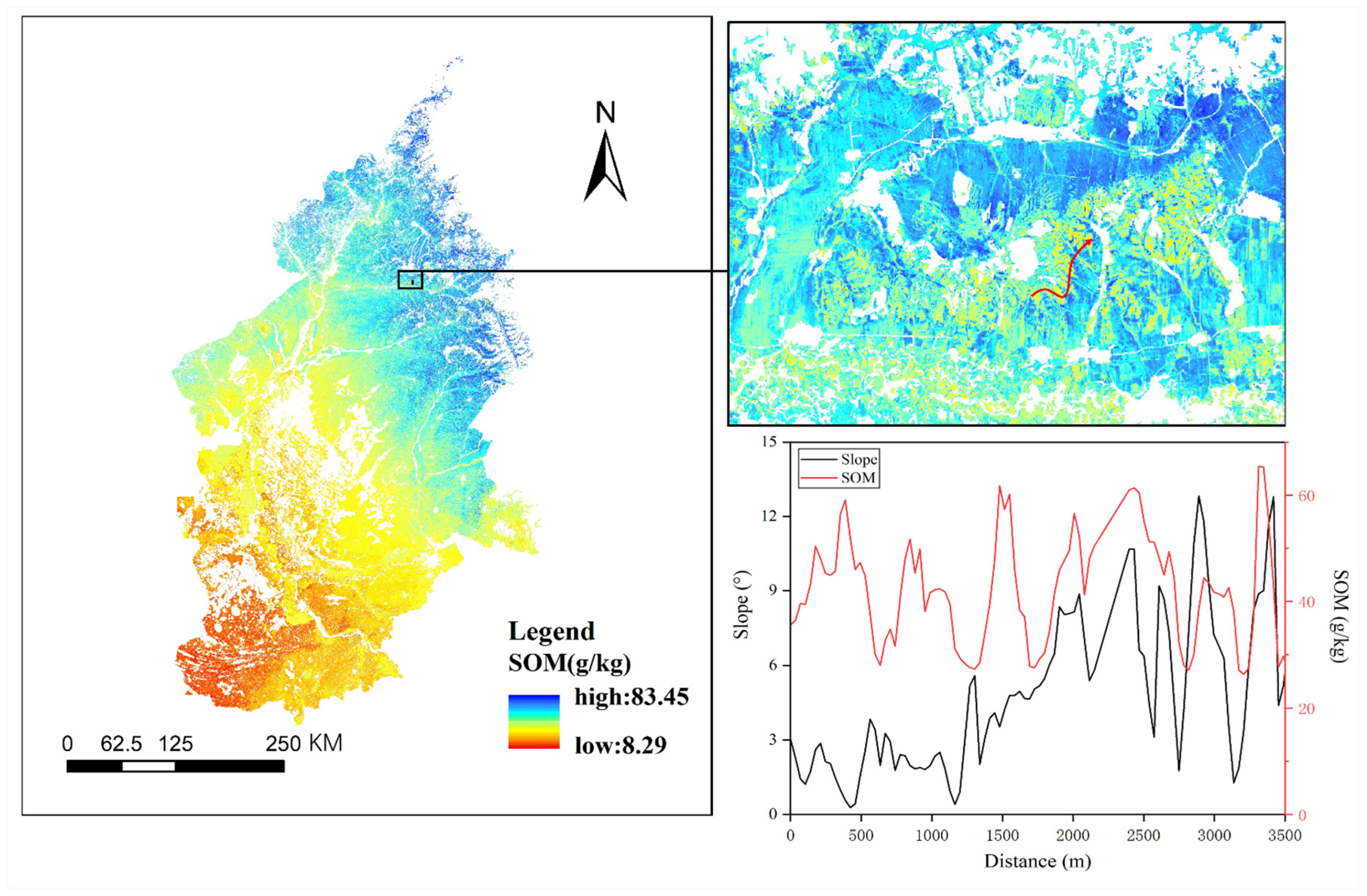

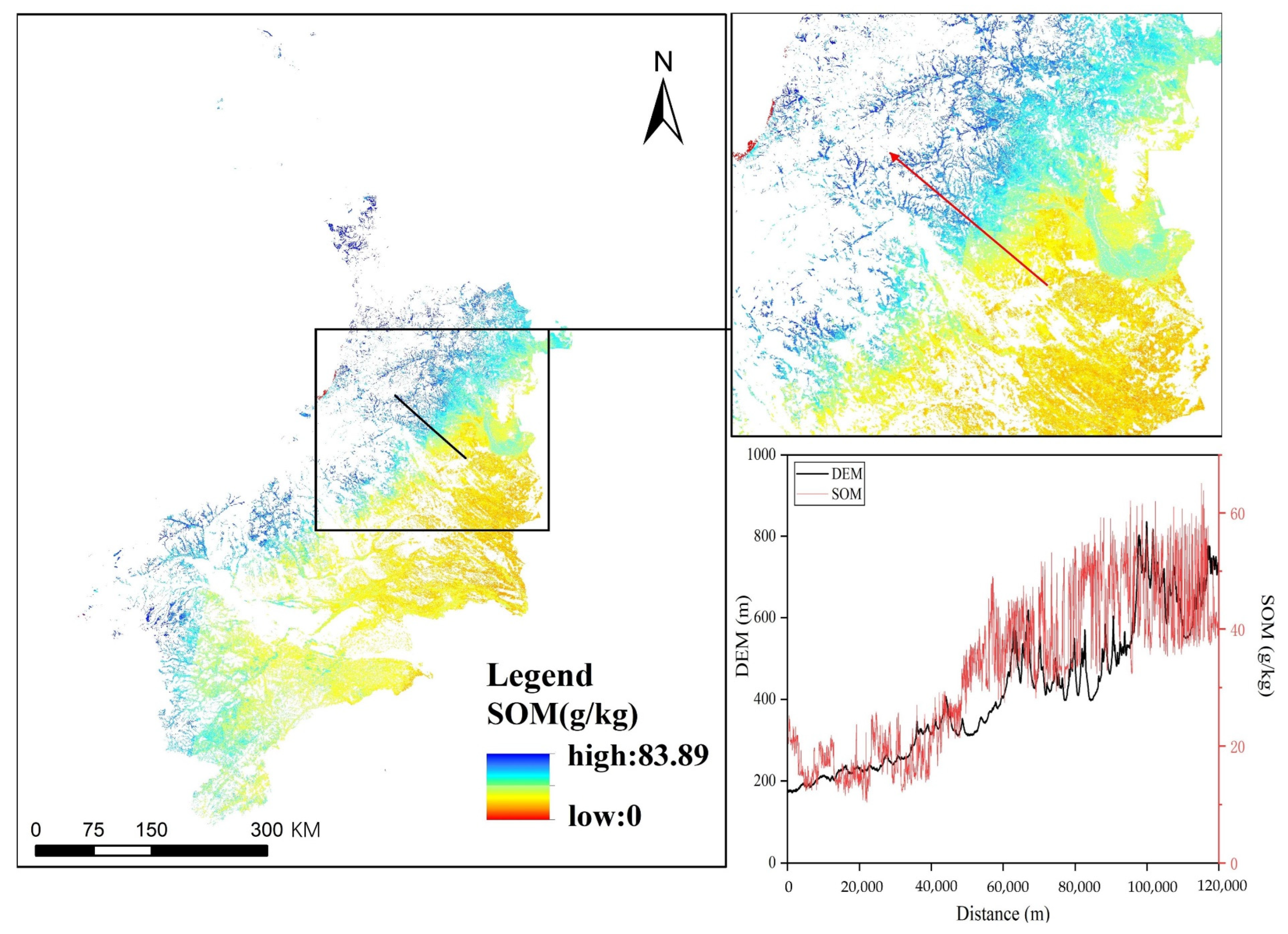

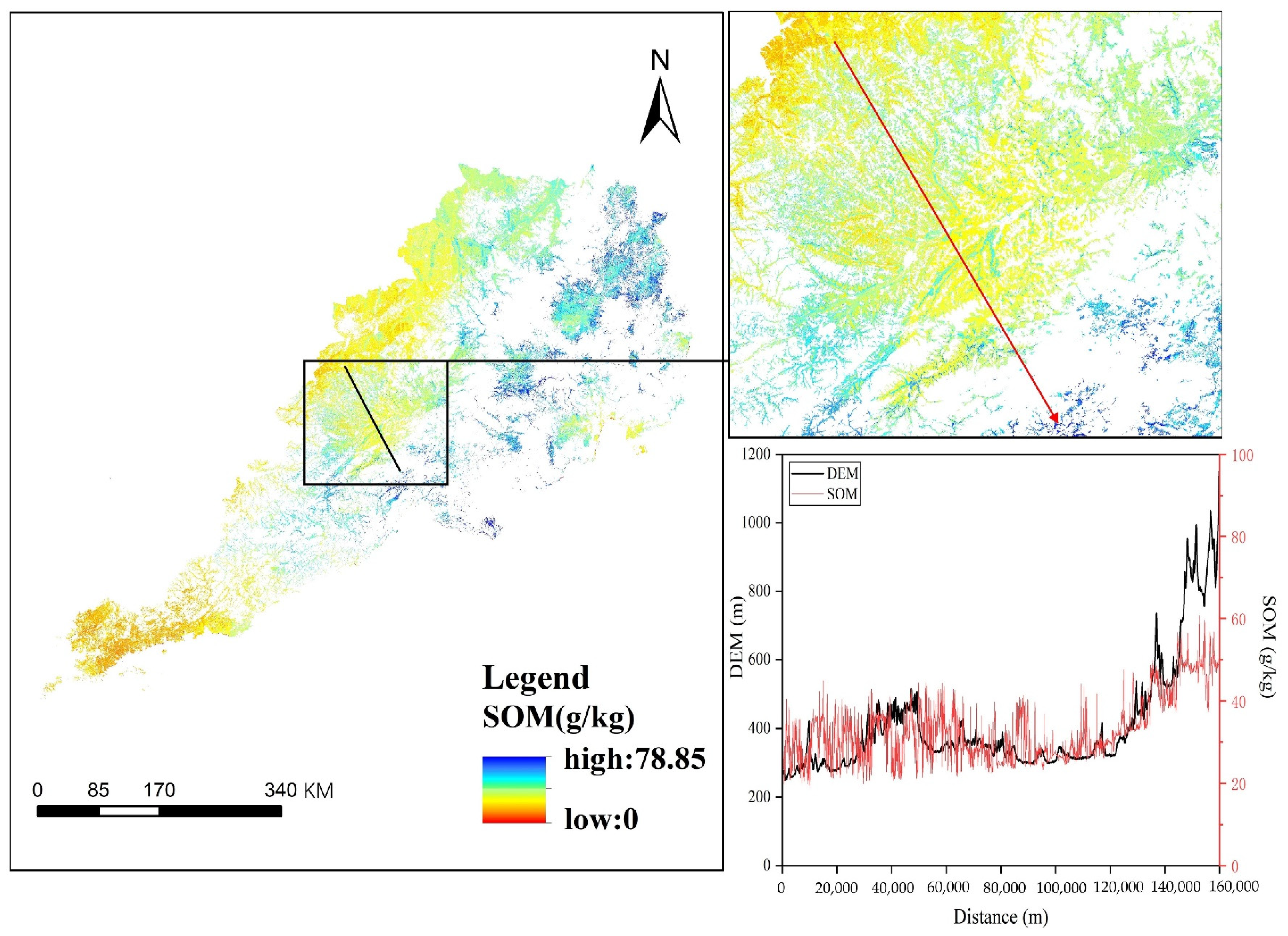
References
- Allison, F.E. Soil Organic Matter and Its Role in Crop Production; Elsevier: Amsterdam, The Netherlands, 1973. [Google Scholar]
- Gurmu, G. Soil organic matter and its role in soil health and crop productivity improvement. For. Ecol. Manag. 2019, 7, 475–483. [Google Scholar]
- Lin, Y.; Feng, Z.; Wu, W.; Yang, Y.; Zhou, Y.; Xu, C. Potential impacts of climate change and adaptation on maize in northeast China. Agron. J. 2017, 109, 1476–1490. [Google Scholar] [CrossRef]
- Zhang, S.; Zhang, X.; Huffman, T.; Liu, X.; Yang, J. Influence of topography and land management on soil nutrients variability in Northeast China. Nutr. Cycl. Agroecosyst. 2011, 89, 427–438. [Google Scholar] [CrossRef]
- Hu, B.; Zhou, Q.; He, C.; Duan, L.; Li, W.; Zhang, G.; Ji, W.; Peng, J.; Xie, H. Spatial variability and potential controls of soil organic matter in the Eastern Dongting Lake Plain in southern China. J. Soils Sediments 2021, 21, 2791–2804. [Google Scholar] [CrossRef]
- Tziachris, P.; Aschonitis, V.; Chatzistathis, T.; Papadopoulou, M. Assessment of spatial hybrid methods for predicting soil organic matter using DEM derivatives and soil parameters. Catena 2019, 174, 206–216. [Google Scholar] [CrossRef]
- Ghotbi, M.; Taghizadeh-Mehrjardi, R.; Knief, C.; Ghotbi, M.; Kent, A.D.; Horwath, W.R. The patchiness of soil 13C versus the uniformity of 15N distribution with geomorphic position provides evidence of erosion and accelerated organic matter turnover. Agric. Ecosyst. Environ. 2023, 356, 108616. [Google Scholar] [CrossRef]
- Musadji, N.Y.; Lemée, L.; Caner, L.; Porel, G.; Poinot, P.; Geffroy-Rodier, C. Spectral characteristics of soil dissolved organic matter: Long-term effects of exogenous organic matter on soil organic matter and spatial-temporal changes. Chemosphere 2020, 240, 124808. [Google Scholar] [CrossRef] [PubMed]
- Gómez, J.A.; Guzmán, G.; Vanwalleghem, T.; Vanderlinden, K. Spatial variability of soil organic carbon stock in an olive orchard at catchment scale in Southern Spain. Int. Soil Water Conserv. Res. 2023, 11, 311–326. [Google Scholar] [CrossRef]
- Shi, P.; Six, J.; Sila, A.; Vanlauwe, B.; Van Oost, K. Towards spatially continuous mapping of soil organic carbon in croplands using multitemporal Sentinel-2 remote sensing. ISPRS J. Photogramm. Remote Sens. 2022, 193, 187–199. [Google Scholar] [CrossRef]
- Wu, C.; Yang, H.; Zheng, Y.; Wu, Z.; Yang, Y. Study on zoning of livestock carrying potential based on spatial distribution of soil organic matter on the Bashang Plateau of northern China. Soil Tillage Res. 2022, 218, 105319. [Google Scholar] [CrossRef]
- Kohl, L.; Philben, M.; Edwards, K.A.; Podrebarac, F.A.; Warren, J.; Ziegler, S.E. The origin of soil organic matter controls its composition and bioreactivity across a mesic boreal forest latitudinal gradient. Glob. Chang. Biol. 2018, 24, e458–e473. [Google Scholar] [CrossRef]
- Lützow, M.v.; Kögel-Knabner, I.; Ekschmitt, K.; Matzner, E.; Guggenberger, G.; Marschner, B.; Flessa, H. Stabilization of organic matter in temperate soils: Mechanisms and their relevance under different soil conditions—A review. Eur. J. Soil Sci. 2006, 57, 426–445. [Google Scholar] [CrossRef]
- Jiménez-González, M.A.; Álvarez, A.M.; Carral, P.; Almendros, G. Influence of soil forming factors on the molecular structure of soil organic matter and carbon levels. Catena 2020, 189, 104501. [Google Scholar] [CrossRef]
- Marchetti, A.; Piccini, C.; Francaviglia, R.; Mabit, L. Spatial distribution of soil organic matter using geostatistics: A key indicator to assess soil degradation status in central Italy. Pedosphere 2012, 22, 230–242. [Google Scholar] [CrossRef]
- Du, Z.; Gao, B.; Ou, C.; Du, Z.; Yang, J.; Batsaikhan, B.; Dorjgotov, B.; Yun, W.; Zhu, D. A quantitative analysis of factors influencing organic matter concentration in the topsoil of black soil in northeast China based on spatial heterogeneous patterns. ISPRS Int. J. Geo-Inf. 2021, 10, 348. [Google Scholar] [CrossRef]
- Dad, J.M.; Shafiq, M.u. Spatial distribution of soil organic carbon in apple orchard soils of Kashmir Himalaya, India. Carbon Manag. 2021, 12, 485–498. [Google Scholar] [CrossRef]
- Zhang, H.; Liu, W.; Hu, Q.; Huang, X. Multi-Scale Integration and Distribution of Soil Organic Matter Spatial Variation in a Coal–Grain Compound Area. Sustainability 2023, 15, 3780. [Google Scholar] [CrossRef]
- Zeng, C.; Yang, L.; Zhu, A.-X.; Rossiter, D.G.; Liu, J.; Liu, J.; Qin, C.; Wang, D. Mapping soil organic matter concentration at different scales using a mixed geographically weighted regression method. Geoderma 2016, 281, 69–82. [Google Scholar] [CrossRef]
- Lu, M.-y.; Liu, Y.; Liu, G.-j. Precise prediction of soil organic matter in soils planted with a variety of crops through hybrid methods. Comput. Electron. Agric. 2022, 200, 107246. [Google Scholar] [CrossRef]
- Shrestha, A.; Luo, W. Analysis of groundwater nitrate contamination in the Central Valley: Comparison of the geodetector method, principal component analysis and geographically weighted regression. ISPRS Int. J. Geo-Inf. 2017, 6, 297. [Google Scholar] [CrossRef]
- Su, Y.; Li, T.; Cheng, S.; Wang, X. Spatial distribution exploration and driving factor identification for soil salinisation based on geodetector models in coastal area. Ecol. Eng. 2020, 156, 105961. [Google Scholar] [CrossRef]
- Luo, C.; Zhang, W.; Zhang, X.; Liu, H. Mapping soil organic matter content using Sentinel-2 synthetic images at different time intervals in Northeast China. Int. J. Digit. Earth 2023, 16, 1094–1107. [Google Scholar] [CrossRef]
- Zhao, X.; Zhang, Z.; Zhao, M.; Song, X.; Liu, X.; Zhang, X. The Quantified and Major Influencing Factors on Spatial Distribution of Soil Organic Matter in Provincial-Scale Farmland—A Case Study of Shandong Province in Eastern China. Appl. Sci. 2023, 13, 3738. [Google Scholar] [CrossRef]
- Wang, J.F.; Li, X.H.; Christakos, G.; Liao, Y.L.; Zhang, T.; Gu, X.; Zheng, X.Y. Geographical detectors-based health risk assessment and its application in the neural tube defects study of the Heshun Region, China. Int. J. Geogr. Inf. Sci. 2010, 24, 107–127. [Google Scholar] [CrossRef]
- Piccini, C.; Marchetti, A.; Francaviglia, R. Estimation of soil organic matter by geostatistical methods: Use of auxiliary information in agricultural and environmental assessment. Ecol. Indic. 2014, 36, 301–314. [Google Scholar] [CrossRef]
- Duveiller, G.; Defourny, P. A conceptual framework to define the spatial resolution requirements for agricultural monitoring using remote sensing. Remote Sens. Environ. 2010, 114, 2637–2650. [Google Scholar] [CrossRef]
- Somantri, L. Land Use: One of Essential Geography Concept Based on Remote Sensing Technology. In IOP Conference Series: Earth and Environmental Science; IOP Publishing: Bristol, UK, 2018. [Google Scholar]
- Guo, L.; Sun, X.; Fu, P.; Shi, T.; Dang, L.; Chen, Y.; Linderman, M.; Zhang, G.; Zhang, Y.; Jiang, Q. Mapping soil organic carbon stock by hyperspectral and time-series multispectral remote sensing images in low-relief agricultural areas. Geoderma 2021, 398, 115118. [Google Scholar] [CrossRef]
- Congalton, R.G. Remote sensing and geographic information system data integration: Error sources and research issues. Photogramm. Eng. Remote Sens. 1991, 57, 677–687. [Google Scholar]
- Chen, B.; Huang, B.; Xu, B. Multi-source remotely sensed data fusion for improving land cover classification. ISPRS J. Photogramm. Remote Sens. 2017, 124, 27–39. [Google Scholar] [CrossRef]
- Sharma, S.K.; Aryal, J.; Rajabifard, A. Remote sensing and meteorological data fusion in predicting bushfire severity: A case study from victoria, australia. Remote Sens. 2022, 14, 1645. [Google Scholar] [CrossRef]
- Hu, W.; Shen, Q.; Zhai, X.; Du, S.; Zhang, X. Impact of environmental factors on the spatiotemporal variability of soil organic matter: A case study in a typical small Mollisol watershed of Northeast China. J. Soils Sediments 2021, 21, 736–747. [Google Scholar] [CrossRef]
- von Lützow, M.; Kögel-Knabner, I. Temperature sensitivity of soil organic matter decomposition—What do we know? Biol. Fertil. Soils 2009, 46, 1–15. [Google Scholar] [CrossRef]
- Amelung, W.; Zech, W.; Flach, K. Climatic effects on soil organic matter composition in the Great Plains. Soil Sci. Soc. Am. J. 1997, 61, 115–123. [Google Scholar] [CrossRef]
- Lloyd, J.; Taylor, J. On the temperature dependence of soil respiration. Funct. Ecol. 1994, 8, 315–323. [Google Scholar] [CrossRef]
- Conant, R.T.; Ryan, M.G.; Ågren, G.I.; Birge, H.E.; Davidson, E.A.; Eliasson, P.E.; Evans, S.E.; Frey, S.D.; Giardina, C.P.; Hopkins, F.M. Temperature and soil organic matter decomposition rates–synthesis of current knowledge and a way forward. Glob. Chang. Biol. 2011, 17, 3392–3404. [Google Scholar] [CrossRef]
- Paul, E.A. The nature and dynamics of soil organic matter: Plant inputs, microbial transformations, and organic matter stabilization. Soil Biol. Biochem. 2016, 98, 109–126. [Google Scholar] [CrossRef]
- Bardgett, R.D.; Freeman, C.; Ostle, N.J. Microbial contributions to climate change through carbon cycle feedbacks. ISME J. 2008, 2, 805–814. [Google Scholar] [CrossRef]
- Navas, A.; Gaspar, L.; Quijano, L.; Lopez-Vicente, M.; Machín, J. Patterns of soil organic carbon and nitrogen in relation to soil movement under different land uses in mountain fields (South Central Pyrenees). Catena 2012, 94, 43–52. [Google Scholar] [CrossRef]
- Huynh, C.V.; Nguyen, P.T.; Pham, T.G.; Nguyen, H.T.; Nguyen, M.T.; Tran, P.T. Evaluation of soil organic matter content under topographic influences in agroforestry ecosystems: A study in Central Vietnam. Eurasian Soil Sci. 2022, 55, 1041–1051. [Google Scholar] [CrossRef]
- Demelash, M.; Stahr, K. Assessment of integrated soil and water conservation measures on key soil properties in South Gonder, North-Western Highlands of Ethiopia. J. Soil Sci. Environ. Manag. 2010, 1, 164–176. [Google Scholar]
- Jobbágy, E.G.; Jackson, R.B. The vertical distribution of soil organic carbon and its relation to climate and vegetation. Ecol. Appl. 2000, 10, 423–436. [Google Scholar] [CrossRef]
- Gutiérrez-Girón, A.; Díaz-Pinés, E.; Rubio, A.; Gavilán, R.G. Both altitude and vegetation affect temperature sensitivity of soil organic matter decomposition in Mediterranean high mountain soils. Geoderma 2015, 237, 1–8. [Google Scholar] [CrossRef]
- Yang, Q.; Zhang, P.; Ma, Z.; Liu, D.; Guo, Y. Agricultural Economic Resilience in the Context of International Food Price Fluctuation—An Empirical Analysis on the Main Grain–Producing Areas in Northeast China. Sustainability 2022, 14, 14102. [Google Scholar] [CrossRef]
- Garrity, D.P. Sustainable land-use systems for sloping uplands in Southeast Asia. Technol. Sustain. Agric. Trop. 1993, 56, 41–66. [Google Scholar]
- Liniger, H.P.; Mekdaschi, R.; Moll, P.; Zander, U. Making Sense of Research for Sustainable Land Management; Centre for Development and Environment (CDE), University of Bern and Helmholtz-Centre for Environmental Research GmbH–UFZ: Bern, Switzerland, 2017. [Google Scholar]
- Nouari, A. Assessment of Management Strategies to Control Water Erosion: A GIS Based RUSLE Approach. Master’s Thesis, PAUWES, Chetouane, Algeria, 2020. [Google Scholar]
- Craswell, E.; Lefroy, R. The role and function of organic matter in tropical soils. In Managing Organic Matter in Tropical Soils: Scope and Limitations: Proceedings of a Workshop Organized by the Center for Development Research at the University of Bonn (ZEF Bonn)—Germany, 7–10 June 1999; Springer: Cham, Switzerland, 1999. [Google Scholar]


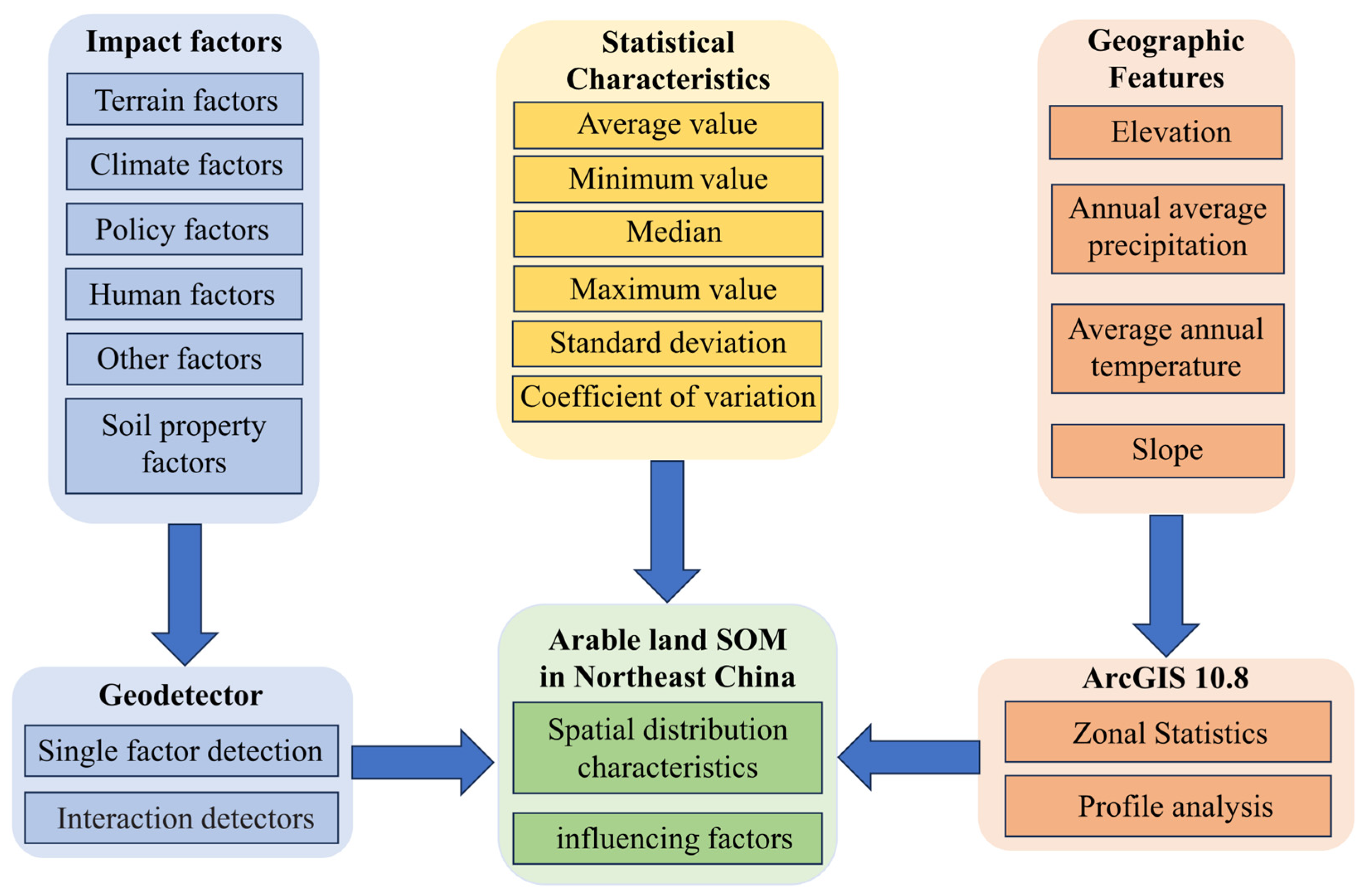

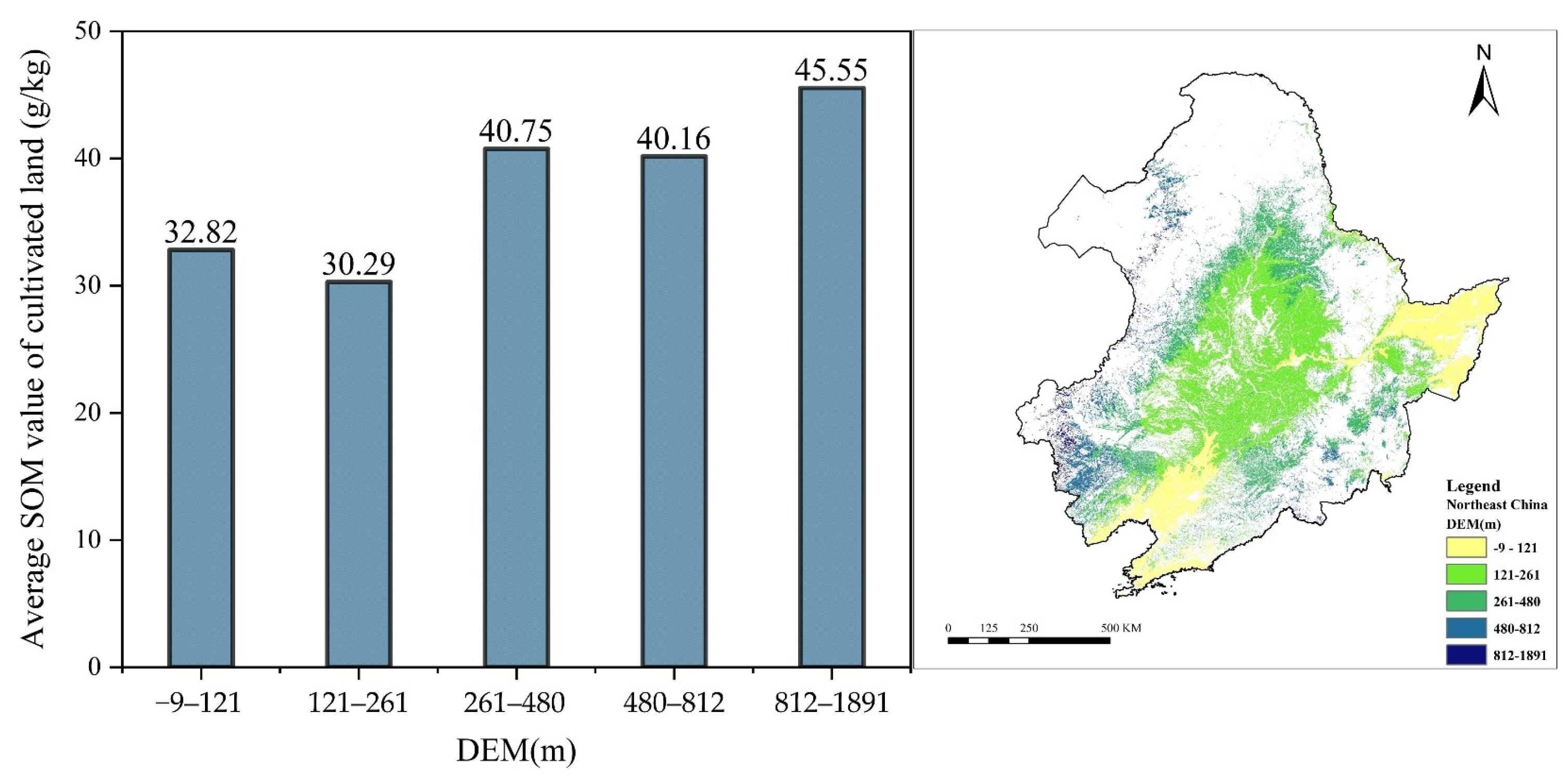
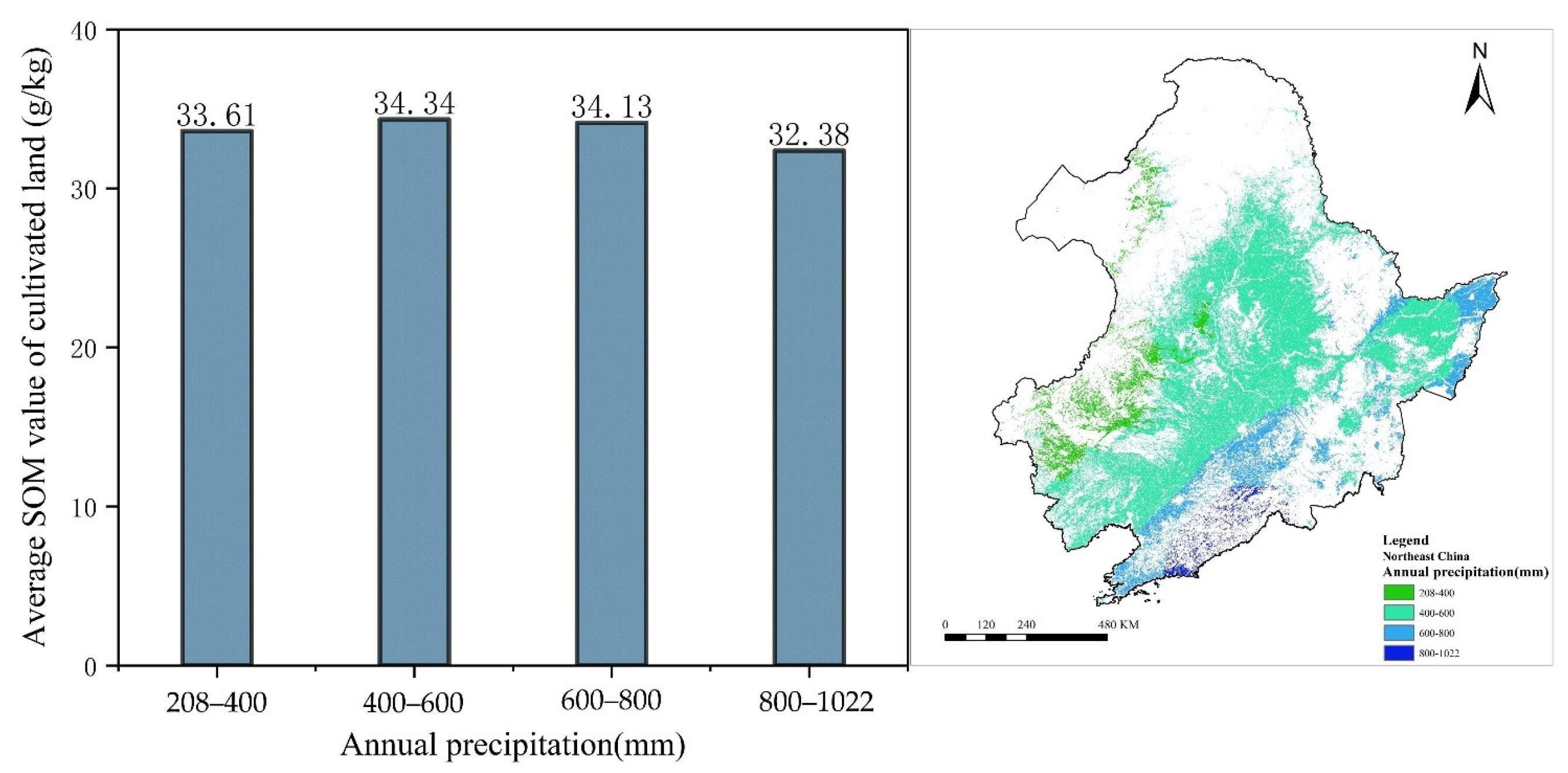

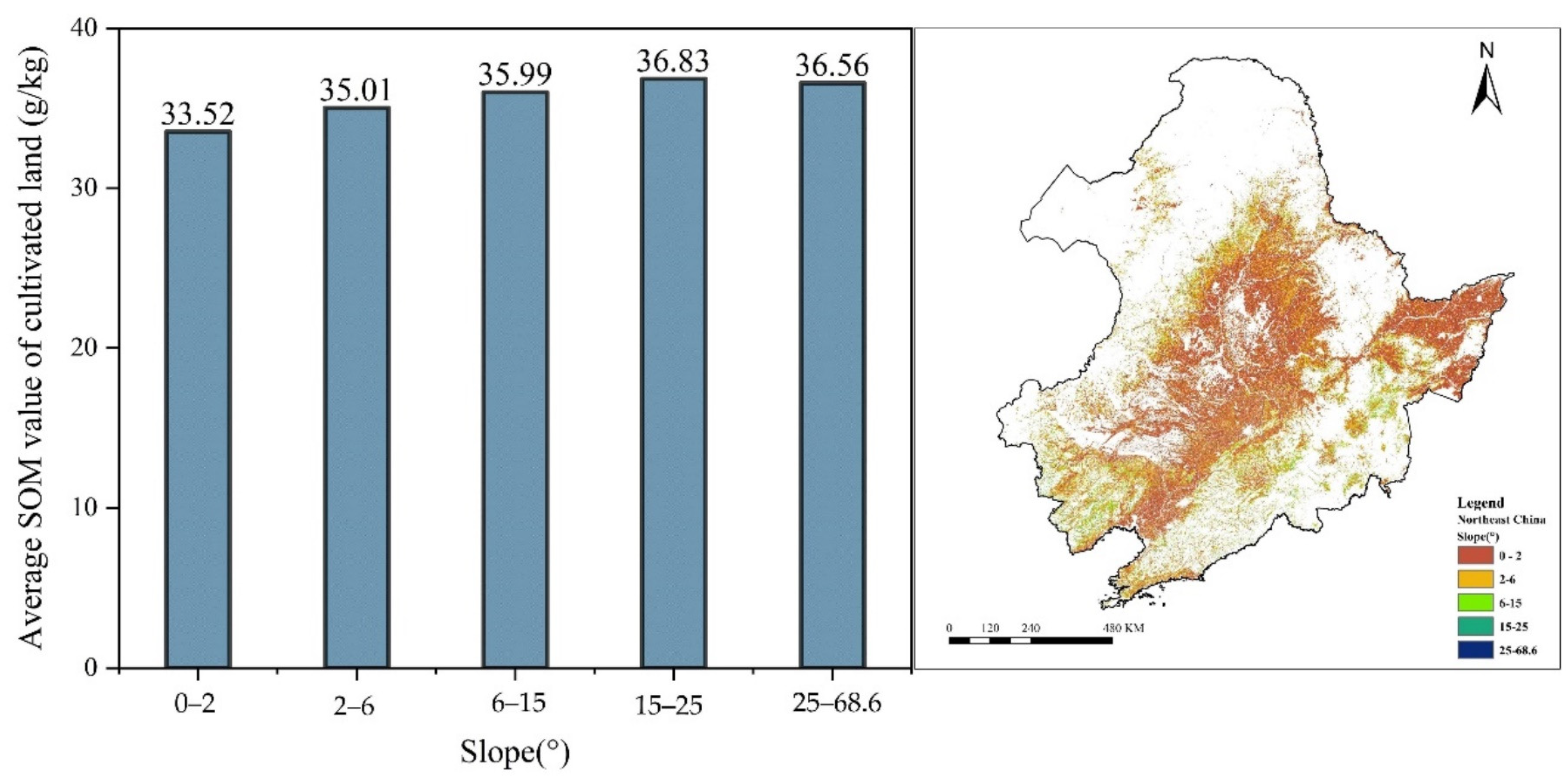

| Data | Data Age | Variable Name | Unit |
|---|---|---|---|
| Terrain factors | |||
| DEM | 2021 | X1 | m |
| SLP | 2021 | X2 | ° |
| Climate factors | |||
| PRE | 2001 to 2020 | X3 | mm |
| TEMP | 2001 to 2020 | X4 | °C |
| Soil property factors | |||
| SOILPH | 2020 | X5 | - |
| SOILT | 2021 | X6 | - |
| Policy factors | |||
| POL1 | 2019 | X7 | - |
| POL2 | 2023 | X8 | - |
| Human factors | |||
| GDP | 2001 to 2020 | X9 | Ten thousand CNY/km2 |
| POP | 2001 to 2020 | X10 | People/km2 |
| Other factors | |||
| RLSF | 2023 | X11 | type |
| TFC | 2023 | X12 | type |
| Geomorphologic Region | Average Value (g/kg) | Minimum Value (g/kg) | Median (g/kg) | Maximum Value (g/kg) | Standard Deviation (g/kg) | Coefficient of Variation (%) |
|---|---|---|---|---|---|---|
| Northeast China | 37.70 | 8.61 | 55.03 | 104.91 | 13.84 | 36.71 |
| GLKM | 49.32 | 8.78 | 53.72 | 104.77 | 10.40 | 21.09 |
| LHP | 28.78 | 8.62 | 51.75 | 99.18 | 10.32 | 35.86 |
| SJP | 44.40 | 8.88 | 54.41 | 104.23 | 9.30 | 20.95 |
| SNP | 43.22 | 8.65 | 54.19 | 104.91 | 12.61 | 29.18 |
| NSA | 26.15 | 8.61 | 51.60 | 100.29 | 11.78 | 45.05 |
| LHPM | 38.05 | 8.81 | 31.07 | 102.96 | 11.54 | 30.33 |
| Regions | Dominant Factors | Level | Measures |
|---|---|---|---|
| GLKM, LHPM, NSA | DEM | High-DEM | Terrace-planted |
| Low-DEM | Drainage System Construction | ||
| LHP, SNP | Slope | High-Slope | Terrace-planted |
| Low-Slope | SWC Engineering |
Disclaimer/Publisher’s Note: The statements, opinions and data contained in all publications are solely those of the individual author(s) and contributor(s) and not of MDPI and/or the editor(s). MDPI and/or the editor(s) disclaim responsibility for any injury to people or property resulting from any ideas, methods, instructions or products referred to in the content. |
© 2024 by the authors. Licensee MDPI, Basel, Switzerland. This article is an open access article distributed under the terms and conditions of the Creative Commons Attribution (CC BY) license (https://creativecommons.org/licenses/by/4.0/).
Share and Cite
Kong, D.; Chu, N.; Luo, C.; Liu, H. Analyzing Spatial Distribution and Influencing Factors of Soil Organic Matter in Cultivated Land of Northeast China: Implications for Black Soil Protection. Land 2024, 13, 1028. https://doi.org/10.3390/land13071028
Kong D, Chu N, Luo C, Liu H. Analyzing Spatial Distribution and Influencing Factors of Soil Organic Matter in Cultivated Land of Northeast China: Implications for Black Soil Protection. Land. 2024; 13(7):1028. https://doi.org/10.3390/land13071028
Chicago/Turabian StyleKong, Depiao, Nanchen Chu, Chong Luo, and Huanjun Liu. 2024. "Analyzing Spatial Distribution and Influencing Factors of Soil Organic Matter in Cultivated Land of Northeast China: Implications for Black Soil Protection" Land 13, no. 7: 1028. https://doi.org/10.3390/land13071028






